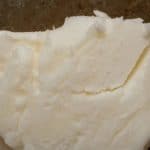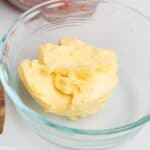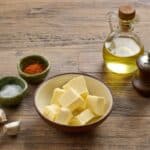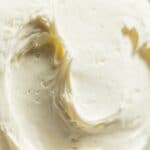Quick summary: Ghee alternatives can be butter, margarine, shortening, or different types of oil. At least one of these replacements you will find in your kitchen, so don’t despair if ghee is not nearby.
Depending on the type of cuisine you cook on a daily basis, ghee might not be a pantry staple in your household. This nutty aromatic version of clarified butter is commonly used in Indian and Middle Eastern recipes.
The luxurious cooking fat is used for sauteing, baking, frying, grilling, roasting, and in sauces.
If your recipe calls for ghee and you don’t have any, this guide will help you choose an instant ghee substitute from items you already have in the pantry.
Before you decide on the best option, let’s look at what ghee is and what you need to consider when choosing a ghee alternative.
What Is Ghee?
Simply put, ghee is pure butter fat. Regular butter contains approximately 17% water and 1 to 2% milk solids.
When unsalted butter is simmered over low heat, the water content evaporates and the milk solids form small clumps. When this mixture is strained, you are left with close to pure butter fat, otherwise known as clarified butter.
Ghee takes this process a step further. Instead of removing the clarified butter from the heat once the milk solids sink to the bottom, the butter is left to simmer a little longer. The proteins turn a light golden brown with a toasty aroma. Once strained at this point, you are left with ghee.
With the milk solids removed, it contains less lactose or casein than butter which makes it tolerable for many people with lactose intolerance.
Since the water is removed, you also won’t find bacteria growing in pure ghee. This means it is highly shelf-stable as long as it is kept free of moisture and other food particles. It makes a great travel companion when camping!
If steam from cooking, water, or crumbs have contaminated the jar, simply store it in the refrigerator for future use.
Ghee has a high smoke point which means it can be used for high-heat cooking without burning. This makes it versatile for a wide range of cooking methods.
If you need to check if opened ghee is still good, here’re all the guides to how long ghee can last and how to tell if it’s spoiled.
How Ghee Is Used in Cooking
Ghee has a distinct nutty aroma which makes it ideal for both sweet and savory recipes. It can be used for frying, or sauteing anything from vegetables and eggs to French toast, pancakes, fritters, meat, and stir fry.
Use it to grease a baking pan or as the fat component in baked goods. It can also be used as a spread, for basting, finishing off rice and potato dishes, or combined into sauces.
The one downside to this luxurious ingredient is that a good quality product can set you back almost four times the amount of butter. Here’s what you can use instead.
Best Substitutes for Ghee
DIY Homemade Ghee
Ghee is easy to make! It’s also easy to mess up so keep a close eye during the process.
Simmer unsalted butter on low to medium heat. After approximately 15 minutes you should see white milk solids that have separated from the oil.
Leaving it just a little longer will allow it to become slightly darker and develop toasty flavor notes. The white milk solids will turn light brown. Strain the liquid to remove any milk solids.
You will be left with clear-golden cooking fat, your own homemade ghee.
Substitute quantity: Replace your homemade version in equal quantities.
Best for: Any recipe that calls for ghee.
Coconut Oil
If you are looking for a vegan option, coconut oil will make a good substitute. The white fat is solid at room temperature. It softens very easily when warmed and will even start to melt from the warmth of your hands.
Coconut oil is also very high in calories and fat, so it doesn’t cut it as a low-fat alternative, however, it is known for some wonderful nourishing health benefits when consumed in moderation.
Coconut oil is available in both refined and unrefined versions. Refined coconut oil makes a better substitute for ghee since it does not have a strong coconut flavor. It also has a higher smoke point which means it can be used more successfully in high heat cooking methods and baking.
Unrefined coconut oil can also be used as a replacement, however, it has a noticeable coconut flavor. The unrefined type is best for low-heat cooking such as light sauteing and can also be used in baking.
Coconut oil is easily available at most grocery stores and comes in at a lower cost than ghee.
Substitute quantity: Replace coconut oil in equal quantities.
Best for: General baking, sauteing, stir-frying, and greasing baking tins.
Butter
Since ghee essentially comes from butter, this makes a good substitute. Although not quite as toasty, butter will add a lovely rich flavor to sauces, baked goods, mashed potatoes, and rice.
The higher water content of butter will affect the texture of baked goods slightly, although the difference for home-baked goods may not even be noticeable.
Butter has a lower smoking point which means it is not a good option for deep frying or high-temperature cooking.
Substitute quantity: Replace butter in equal measures.
Best for: Baking, sauteing, sauces, using as a spread, or for finishing off a dish.
Butter has a relatively short shelf life, so pay attention to possible signs of spoilage if it’s open for a few weeks.
Clarified Butter
Besides having less toasted and nutty flavor notes, clarified butter is almost identical. This means that in terms of texture and cooking properties, you will get a very similar outcome for baked recipes and general cooking.
It yields a lovely crispy texture on fried items and pairs well with almost any flavor. If you are looking for an alternative that is lower in fat or vegan friendly, however, this is not a suitable option.
Substitute quantity: Replace clarified butter in a one to one ratio.
Best for: Baking, greasing, sauteing, frying foods, roasting, grilling, and sauces.
Vegetable Oil
Vegetable oil, canola oil, and safflower oil, all make good alternatives in recipes where a solid fat consistency is not a prerequisite for success.
These oils have a high smoke point and neutral flavor which makes them suitable for sweet and savory recipes and high-heat cooking methods.
You probably already have some kind of vegetable in your pantry already, so it’s an easy swap.
Substitute quantity: When used for stovetop cooking, you can replace vegetable oil in equal amounts. When baking, use ¾ cup vegetable oil to replace 1 cup. You may need to alter the liquid ratio elsewhere in your recipe to prevent the consistency from becoming too runny.
Best for: Sauteing, baking, frying, grilling, and roasting.
Vegetable oil shelf life is long, but it can surely go bad. Learn how to recognize if it’s rotten.
Olive Oil
Olive oil’s distinct flavor is one of the reasons it makes a great substitute. It is generally best for savory recipes although it can be used in some baked goods where the olive oil taste won’t overpower other delicate flavors.
Since it is a liquid, you will have to adjust the quantity of liquid ingredients elsewhere in your recipe to prevent a change in consistency, especially in baked goods.
Olive oil does not have a high smoke point which means it is not a good choice for frying or other prolonged high-heat cooking methods.
It is generally recommended for use in applications where it does not need to be cooked such as dressings, dipping sauces, and finishing off a dish just before serving.
It won’t help if the oil has become rancid, so keep in mind that olive oil can expire.
Substitute quantity: When used for sauteing, replace olive oil in equal quantities. When baking, start with ¾ cup olive oil to replace 1 cup ghee. Add a little more if needed.
Best for: Drizzling over dishes as a finishing touch, light pan frying, salad dressings, and dense baked goods such as muffins and bread.
Sesame Oil
Sesame oil has a very pronounced flavor and is best used in small quantities. It won’t be suitable for sweet recipes and also not for replacing in large quantities.
However, sesame oil will add a lovely nutty taste to sautéed vegetables, stir-fry, and even chicken or fish dishes. It comes in different varieties such as light, cold-pressed, and toasted sesame oil. Using the toasted version will give you the most intense flavor.
Substitute quantity: Start with ¾ of the amount your recipe calls for to prevent an overpowering flavor and overly oily dish. Add a little more if needed.
Best for: Rice and noodle recipes, stir fries, drizzling over dishes as a finishing touch, and sauteing.
Here’s more on sesame oil duration and how to tell if it’s off.
Soybean Oil
Soybean oil is highly versatile and great for almost any cooking application. Manufactured variants have a neutral flavor and high smoking point which makes it great for anything from donuts to curry. Raw soybean oil, on the other hand, has a slight green bean flavor.
Substitute quantity: Start with ¾ of the amount your recipe calls for. You may need to reduce the liquid quantity elsewhere in your recipe if used in large amounts.
Best for: Frying, baking, sauteing, grilling, dressings, and roasting.
Shortening
Shortening is solid at room temperature and melts when heated. This makes it the ideal substitute in baked goods. It is made from hydrogenated vegetable oils, including palm and soybean oil.
Shortening has a neutral taste which means you won’t get the same nutty flavor in your dish, but this also allows you to pair it with any other flavors without being worried about it overpowering the taste.
It has a slightly lower smoke point but can be used successfully as a replacement in most types of cooking.
Substitute quantity: Replace shortening in equal quantities. For baked goods, you can optionally add an extra tablespoon per cup called for in your recipe.
Best for: Baking, greasing baking pans, sauteing, roasting, grilling, and sauces. It can also be used to finish mashed potatoes or seasoned vegetables.
If you have an expired jar, you don’t have to throw it away immediately. Here’s the shortening shelf life and how to tell when to discard it.
Margarine
Although very similar, margarine and vegetable shortening are not the same. Both products are made largely from hydrogenated vegetable oil, but margarine additionally contains milk solids, water, and a subtle flavoring.
Margarine was designed to be a cheaper version of butter. It has a solid, yet spreadable, consistency and melts when heated but should not be used for frying. Margarine will last longer than butter but not indefinitely, so check for spoilage signs if unsure.
It also has a lower fat content than shortening at around 80% overall fat. You do, however, get varieties with a significantly lower fat percentage, generally used for spreading on bread, toast, scones, and other baked delights.
Substitute quantity: Replace margarine in equal quantities. For baked goods, you can optionally add an extra tablespoon per cup called for in your recipe.
Best for: Baking, greasing baking tins, low-heat cooking, sauteing, sauces, finishing potato and rice dishes, spreading on bread or naan.
FAQ
Although rapeseed oil can work well in most dishes as a ghee substitute, it is recommended to only consume occasionally. It contains high levels of erucic acid. This can be harmful to your health when consumed often.
Yes, it can be an ideal substitute since it has a high smoke point and does not have an overpowering taste. It is great for frying, sauteing, and baking. As with other oils, you may have to reduce the liquid quantity elsewhere in your recipe when used in baked goods to prevent your dough from being too runny.
Yes, ghee can be frozen for over a year. Make sure to keep it in an airtight container.
Ghee that is exposed to moisture, air, heat, or light, for too long will oxidize and turn rancid. It develops a sour flavor and odor and may turn white instead of yellow.
When choosing the best ghee substitute is it important to consider the flavor, consistency, and smoke point of the alternative you choose. If your recipe requires a solid or semi-solid fat, butter, clarified butter, shortening, or margarine are all great replacements.
On the other hand, if you need to cook at very high temperatures, such as when deep frying, a liquid alternative with a high smoke point such as soybean or vegetable oil is a more appropriate choice.
If you follow a vegan diet, olive or coconut oil are both wonderful vegan substitutes.
Whichever substitute you choose, these fats will all add a luxurious richness to your dish.
*image by NazarNazaruk/depositphotos









